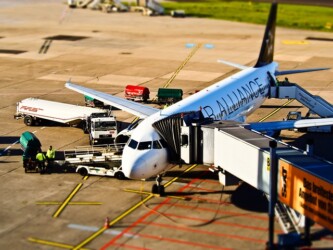Airports around the world are facing the challenge of finding alternative fuels to meet their sustainability goals. In the UK, the aviation industry aims to achieve net zero carbon emissions by 2040, while the US and the European Union have similar targets. One option is Sustainable Aviation Fuel (SAF), which is already being used by airlines. However, there are concerns about its cost and availability. As a result, there is growing interest in hydrogen as a fuel source. Hydrogen has the advantage of storing a large amount of energy and producing no CO2 emissions when used as fuel.
To be used in aviation, hydrogen needs to be in its liquid form, which requires chilling it to minus 253C. Handling liquid hydrogen at such low temperatures is challenging, as it can easily escape as a gas. Therefore, tanks, pipes, and hoses need to be extra-insulated to keep the liquid cold. France’s Air Liquide, which has experience supplying cryogenic hydrogen to the European Space Agency, has been investigating the potential of hydrogen in the aviation industry. They have successfully flown an aircraft using liquid hydrogen and are confident that they can deliver liquid hydrogen quickly for refueling.
However, the installation of the necessary equipment to store and distribute hydrogen at airports will be expensive. Estimates suggest it could cost up to a billion dollars per airport. One start-up, Universal Hydrogen, has proposed a solution. They have developed special tanks, called modules, to hold liquid hydrogen. These modules can be trucked to the airport and plugged directly into the aircraft’s propulsion system, eliminating the need for pipes and pumps. The modules are well-insulated and can keep the hydrogen in its liquid form for four days. Universal Hydrogen is modifying a regional airliner to run on hydrogen and plans to conduct test flights next year.
While hydrogen-powered aircraft are still in the early stages of development, it is uncertain whether hydrogen will become a mainstream fuel for aviation. There are challenges, such as the limited space for fuel storage in the fuselage of hydrogen planes and the availability of environmentally-friendly hydrogen. The aviation industry acknowledges the need to achieve net zero emissions but the path to get there and the economics involved are still unclear. Hydrogen-fueled aircraft may have some demonstration flights in the next decade, but large-scale implementation seems farther away and uncertain.
Original news source: Could airports make hydrogen work as a fuel? (BBC)
Listen
Slow
Normal
Fast
Group or Classroom Activities
Warm-up Activities:
– News Summary
Instructions: Divide the class into pairs or small groups. Give each group a few minutes to read the article. Then, ask each group to summarize the main points of the article in a news summary format, including the key information and any important details. Afterward, have each group share their news summary with the rest of the class.
– Opinion Poll
Instructions: Divide the class into pairs or small groups. Assign each group a role – either “pro” or “con” for the use of hydrogen as a fuel source in aviation. Give the groups a few minutes to discuss and gather their thoughts. Then, have each group create a set of survey questions related to their assigned stance. Afterward, have each group go around the class and conduct an opinion poll by asking their survey questions to different groups. Finally, have each group share the results of their opinion poll with the rest of the class.
– Sketch It
Instructions: Divide the class into pairs or small groups. Assign each group a different aspect or challenge mentioned in the article (e.g. cost and availability of Sustainable Aviation Fuel, challenges of handling liquid hydrogen, installation of necessary equipment at airports, etc.). Give each group a few minutes to discuss and brainstorm ideas. Then, ask each group to create a sketch or drawing that represents their assigned aspect or challenge. Afterward, have each group present their sketch to the rest of the class and explain their representation.
– Vocabulary Pictionary
Instructions: Write down a list of vocabulary words from the article on the board (e.g. sustainability, emissions, fuel source, availability, insulated, etc.). Divide the class into pairs or small groups. Assign each group a vocabulary word. Give the groups a few minutes to discuss and come up with a simple drawing or illustration that represents their assigned word. Then, have each group take turns presenting their drawing to the rest of the class. The rest of the class can guess what word the drawing represents.
– Future Predictions
Instructions: Divide the class into pairs or small groups. Ask each group to discuss and make predictions about the future of hydrogen as a fuel source in aviation. Prompt them to consider the challenges mentioned in the article, as well as any other factors they think may influence the adoption of hydrogen in aviation. Afterward, have each group share their predictions with the rest of the class and engage in a class discussion about the different perspectives and possibilities.
Comprehension Questions:
1. What are the sustainability goals for airports in the UK, US, and the European Union?
2. What is one alternative fuel option that airports are considering?
3. What are the concerns about using Sustainable Aviation Fuel (SAF)?
4. Why does hydrogen need to be in its liquid form to be used in aviation?
5. What are the challenges of handling liquid hydrogen at low temperatures?
6. How has France’s Air Liquide been involved in investigating hydrogen in the aviation industry?
7. What is the estimated cost of installing the necessary equipment to store and distribute hydrogen at airports?
8. How is Universal Hydrogen proposing to solve the challenges of storing and distributing hydrogen at airports?
Go to answers ⇩
Listen and Fill in the Gaps:
Airports around the world are facing the challenge of finding alternative fuels to meet their sustainability goals. In the UK, the aviation (1)______ aims to achieve net zero carbon emissions by 2040, while the US and the (2)______ Union have similar targets. One option is Sustainable Aviation Fuel (SAF), which is already being used by airlines. However, there are (3)______ about its cost and availability. As a result, there is growing interest in hydrogen as a fuel source. Hydrogen has the advantage of storing a large (4)______ of energy and producing no CO2 emissions when used as fuel.
To be used in aviation, hydrogen needs to be in its liquid form, which (5)______ chilling it to minus 253C. (6)______ liquid hydrogen at such low temperatures is challenging, as it can easily (7)______ as a gas. Therefore, tanks, pipes, and hoses need to be extra-insulated to keep the liquid cold. France’s Air Liquide, which has experience supplying (8)______ hydrogen to the European Space Agency, has been investigating the potential of hydrogen in the aviation industry. They have successfully flown an aircraft using liquid hydrogen and are confident that they can deliver liquid hydrogen quickly for refueling.
However, the installation of the necessary equipment to store and distribute hydrogen at (9)______ will be expensive. Estimates suggest it could cost up to a billion dollars per airport. One start-up, Universal Hydrogen, has proposed a solution. They have developed special tanks, called modules, to hold (10)______ hydrogen. These modules can be trucked to the airport and (11)______ directly into the aircraft’s (12)______ system, eliminating the need for pipes and pumps. The modules are well-insulated and can keep the hydrogen in its liquid form for four days. Universal Hydrogen is modifying a regional airliner to run on hydrogen and plans to conduct test flights next year.
While hydrogen-powered aircraft are still in the early stages of development, it is uncertain whether hydrogen will become a mainstream fuel for (13)______. There are challenges, such as the limited space for fuel storage in the (14)______ of hydrogen planes and the (15)______ of environmentally-friendly hydrogen. The aviation industry acknowledges the need to achieve net zero emissions but the path to get there and the economics involved are still unclear. Hydrogen-fueled aircraft may have some demonstration flights in the next (16)______, but large-scale implementation seems farther away and uncertain.
Go to answers ⇩
Discussion Questions:
Students can ask a partner these questions, or discuss them as a group.
1. What are the sustainability goals for airports around the world?
2. How do you feel about the aviation industry’s aim to achieve net zero carbon emissions by 2040?
3. Do you think Sustainable Aviation Fuel (SAF) is a viable option for meeting sustainability goals? Why or why not?
4. What do you think are the main concerns about the cost and availability of Sustainable Aviation Fuel?
5. How would you feel about using hydrogen as a fuel source for aviation?
6. What are the advantages of hydrogen as a fuel source?
7. What challenges might arise from handling liquid hydrogen at low temperatures?
8. Do you think it is worth the expensive installation of equipment to store and distribute hydrogen at airports? Why or why not?
9. What do you think of Universal Hydrogen’s proposed solution for transporting and using liquid hydrogen at airports?
10. How do you think the limited space for fuel storage in hydrogen planes could impact their viability?
11. What do you think are the main challenges in achieving environmentally-friendly hydrogen production?
12. How do you think the aviation industry can achieve net zero emissions while also considering the economics involved?
13. Do you think hydrogen-fueled aircraft will become a mainstream option in the future? Why or why not?
14. How might the implementation of hydrogen-fueled aircraft impact the aviation industry?
15. What are your thoughts on the future of sustainable aviation and the role of hydrogen as a fuel source?
Individual Activities
Vocabulary Meanings:
Match each word to its meaning.
Words:
1. alternative
2. emissions
3. Sustainable Aviation Fuel (SAF)
4. hydrogen
5. liquid
6. equipment
7. modules
8. implementation
Meanings:
(a) A type of fuel that is environmentally friendly
(b) The release of gases into the atmosphere
(c) The act of putting a plan or idea into action
(d) In a state that is neither solid nor gas
(e) Special tanks used to hold liquid hydrogen
(f) A gas that can be used as a fuel source
(g) Tools or machinery needed for a specific purpose
(h) An option or choice that is different
Go to answers ⇩
Multiple Choice Questions:
1. What is one of the challenges airports face in meeting their sustainability goals?
(a) Finding alternative fuels
(b) Increasing passenger capacity
(c) Reducing flight delays
(d) Improving baggage handling
2. What is one advantage of using hydrogen as a fuel source in aviation?
(a) Is readily available
(b) Produces no CO2 emissions
(c) Is cheaper than other fuels
(d) Stores less energy than other fuels
3. Why does hydrogen need to be in its liquid form for aviation use?
(a) It is easier to handle as a liquid
(b) It produces more energy in liquid form
(c) It needs to be chilled to minus 253C
(d) It is more readily available as a liquid
4. What company has experience supplying cryogenic hydrogen to the European Space Agency?
(a) Universal Hydrogen
(b) Air Liquide
(c) Sustainable Aviation Fuel
(d) European Union
5. What is one potential drawback of using hydrogen as a fuel source in aviation?
(a) High cost of liquid hydrogen
(b) Difficulty in handling liquid hydrogen
(c) Lack of interest from airlines
(d) Limited space for fuel storage in the fuselage
6. How does Universal Hydrogen propose to transport and store liquid hydrogen at airports?
(a) Using special tanks called modules
(b) Using pipes and pumps
(c) Using cryogenic containers
(d) Using existing fuel storage systems
7. What is one potential cost of installing the necessary equipment to store and distribute hydrogen at airports?
(a) Up to a million dollars per airport
(b) Up to a hundred thousand dollars per airport
(c) Up to a billion dollars per airport
(d) Up to ten million dollars per airport
8. What is the current status of hydrogen-powered aircraft in the aviation industry?
(a) Already being used by airlines
(b) Widely implemented and successful
(c) Not considered a viable option for aviation
(d) Still in the early stages of development
Go to answers ⇩
True or False Questions:
1. Handling liquid hydrogen at low temperatures is challenging, as it can easily escape as a gas.
2. There are no concerns about the cost and availability of Sustainable Aviation Fuel.
3. Hydrogen cannot store a large amount of energy and produces CO2 emissions when used as fuel.
4. The UK aviation industry aims to achieve net zero carbon emissions by 2040.
5. Hydrogen is not being considered as a potential fuel source for aviation.
6. Sustainable Aviation Fuel (SAF) is already being used by airlines.
7. The installation of necessary equipment to store and distribute hydrogen at airports would be expensive.
8. Airports around the world are not striving to find alternative fuels to meet sustainability goals.
Go to answers ⇩
Write a Summary:
Write a summary of this news article in two sentences.
Check your writing now with the best free AI for English writing!
Writing Questions:
Answer the following questions. Write as much as you can for each answer.
Check your answers with our free English writing assistant!
1. What are the sustainability goals for airports around the world?
2. What are the concerns about using Sustainable Aviation Fuel (SAF)?
3. How does hydrogen need to be stored in order to be used in aviation?
4. What is the estimated cost of installing the necessary equipment to store and distribute hydrogen at airports?
5. What challenges are associated with using hydrogen as a fuel source for aviation?
Answers
Comprehension Question Answers:
1. The sustainability goals for airports in the UK, US, and the European Union are to achieve net zero carbon emissions by 2040.
2. One alternative fuel option that airports are considering is Sustainable Aviation Fuel (SAF).
3. The concerns about using Sustainable Aviation Fuel (SAF) are its cost and availability.
4. Hydrogen needs to be in its liquid form to be used in aviation because it needs to be chilled to minus 253C.
5. The challenges of handling liquid hydrogen at low temperatures include the risk of it easily escaping as a gas and the need for extra insulation to keep it cold.
6. France’s Air Liquide has been involved in investigating hydrogen in the aviation industry by supplying cryogenic hydrogen to the European Space Agency and successfully flying an aircraft using liquid hydrogen.
7. The estimated cost of installing the necessary equipment to store and distribute hydrogen at airports is up to a billion dollars per airport.
8. Universal Hydrogen is proposing to solve the challenges of storing and distributing hydrogen at airports by developing special tanks called modules, which can be trucked to the airport and plugged directly into the aircraft’s propulsion system. These modules are well-insulated and can keep the hydrogen in its liquid form for four days.
Go back to questions ⇧
Listen and Fill in the Gaps Answers:
(1) industry
(2) European
(3) concerns
(4) amount
(5) requires
(6) Handling
(7) escape
(8) cryogenic
(9) airports
(10) liquid
(11) plugged
(12) propulsion
(13) aviation
(14) fuselage
(15) availability
(16) decade
Go back to questions ⇧
Vocabulary Meanings Answers:
1. alternative
Answer: (h) An option or choice that is different
2. emissions
Answer: (b) The release of gases into the atmosphere
3. Sustainable Aviation Fuel (SAF)
Answer: (a) A type of fuel that is environmentally friendly
4. hydrogen
Answer: (f) A gas that can be used as a fuel source
5. liquid
Answer: (d) In a state that is neither solid nor gas
6. equipment
Answer: (g) Tools or machinery needed for a specific purpose
7. modules
Answer: (e) Special tanks used to hold liquid hydrogen
8. implementation
Answer: (c) The act of putting a plan or idea into action
Go back to questions ⇧
Multiple Choice Answers:
1. What is one of the challenges airports face in meeting their sustainability goals?
Answer: (a) Finding alternative fuels
2. What is one advantage of using hydrogen as a fuel source in aviation?
Answer: (b) Produces no CO2 emissions
3. Why does hydrogen need to be in its liquid form for aviation use?
Answer: (c) It needs to be chilled to minus 253C
4. What company has experience supplying cryogenic hydrogen to the European Space Agency?
Answer: (b) Air Liquide
5. What is one potential drawback of using hydrogen as a fuel source in aviation?
Answer: (d) Limited space for fuel storage in the fuselage
6. How does Universal Hydrogen propose to transport and store liquid hydrogen at airports?
Answer: (a) Using special tanks called modules
7. What is one potential cost of installing the necessary equipment to store and distribute hydrogen at airports?
Answer: (c) Up to a billion dollars per airport
8. What is the current status of hydrogen-powered aircraft in the aviation industry?
Answer: (d) Still in the early stages of development
Go back to questions ⇧
True or False Answers:
1. Handling liquid hydrogen at low temperatures is challenging, as it can easily escape as a gas. (Answer: True)
2. There are no concerns about the cost and availability of Sustainable Aviation Fuel. (Answer: False)
3. Hydrogen cannot store a large amount of energy and produces CO2 emissions when used as fuel. (Answer: False)
4. The UK aviation industry aims to achieve net zero carbon emissions by 2040. (Answer: True)
5. Hydrogen is not being considered as a potential fuel source for aviation. (Answer: False)
6. Sustainable Aviation Fuel (SAF) is already being used by airlines. (Answer: True)
7. The installation of necessary equipment to store and distribute hydrogen at airports would be expensive. (Answer: True)
8. Airports around the world are not striving to find alternative fuels to meet sustainability goals. (Answer: False)
Go back to questions ⇧













